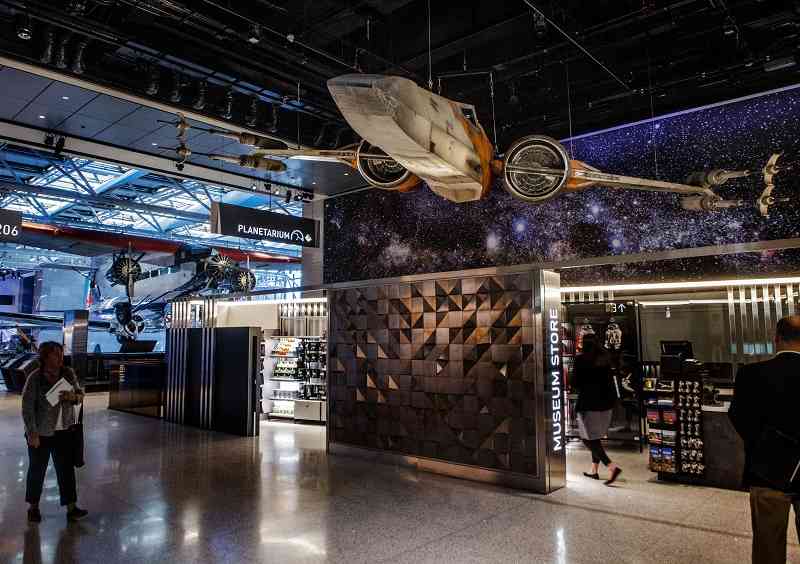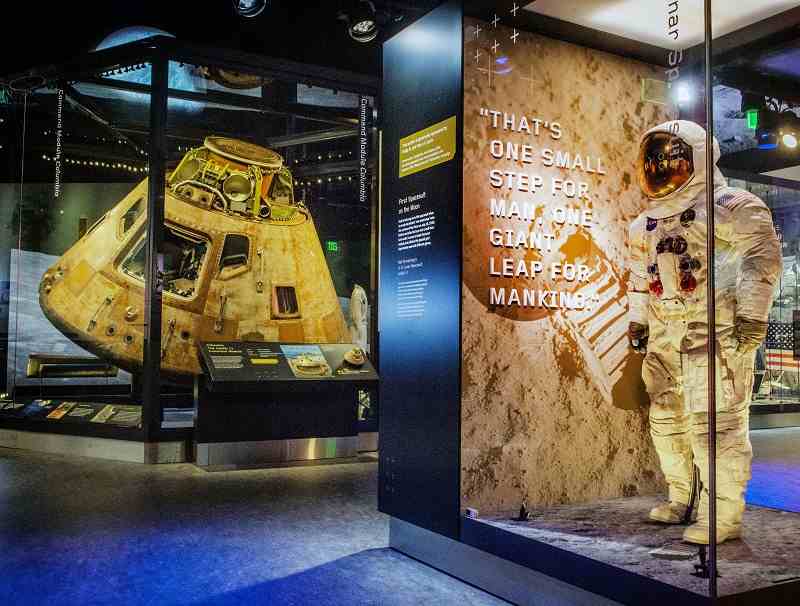Smithsonian Air and Space Museum to reopen next week

A full-size X-wing fighter from the Star Wars cinematic universe hangs at the Smithsonian’s National Air and Space Museum in Washington, D.C., on Oct. 6, 2022. The west wing of the museum, which has been closed since March, will reopen on Oct. 14.
13:43 JST, October 7, 2022
The Apollo 11 moon capsule sits on an angle in the eerie light of its display case, its heat shield still gouged from its 25,000 mph plunge through the atmosphere in 1969.
Nearby, the 1909 Wright brothers flier – the world’s first military airplane – still has oil stains on its fabric wings near the engine and the big bicycle chains that turned the propellers.
And in another museum gallery, fragments of the Wrights’ original 1903 flier that were taken to the moon in 1969 sit like sacred relics in a small case.
These and other treasures were unveiled Thursday at the Smithsonian Institution’s National Air and Space Museum, which reopens its west wing to the public Oct. 14.
The museum, on the National Mall in Washington, has been closed since March, and the west wing has been closed for extensive renovations since 2018.
The east wing is now closed and undergoing similar upgrades. The seven-year project is expected to be finished in 2025.
The renovated wing is packed with glorious old standards – the 1929 Ford TriMotor, nicknamed the “Tin Goose”; the sleek, gray Boeing 247-D airliner from 1933; and the shiny twin-engine Douglas DC-3, which flew from the 1930s to the 1950s.
Newly presented is German aviation pioneer Otto Lilienthal’s elegant Standard Glider, an antique version of the modern hang glider.
The 1894 bat-winged craft is the only original Lilienthal glider in the Western Hemisphere, and one of only six that still survive, the museum says.
Lilienthal was known in his day as “the Flying Man.” He was killed in 1896 when a gust of wind upended the glider he was flying. It fell to the ground from 50 feet, and Lilienthal broke his spine. He died the next day in a Berlin hospital.
Another early aircraft fatality was that of the scarcely remembered American journalist-aviator Harriet Quimby. The museum features a photo of her in gloves, hat and flying suit.
She became the first woman to fly solo across the English Channel on April 16, 1912, in a Bleriot monoplane. But her stunning feat was overshadowed by the sinking of the Titanic the day before.

The Apollo 11 command module behind glass at the Smithsonian’s National Air and Space Museum in Washington, D.C., on Oct. 6, 2022. The museum, which has been closed since March, will reopen half of its flagship building to the public next week with eight new and renovated exhibitions.
Two months after that, at a Boston aviation show, her plane flipped over in flight. She and a passenger fell out of their seats into Dorchester Harbor and were killed.
Her death brought a benefit, however. “That incident, which was highly publicized, started to get people to put seat belts in airplanes,” senior museum curator Peter Jakab said.
The renovated wing was opened to the media after remarks by museum director Christopher Browne.
“I can’t tell you how excited and pleased we are to be at this moment,” he said. “This is an early glimpse . . . of what we’re going to unveil to the American public here a week from tomorrow.”
He said more than 350 million visitors had come through the museum since it opened in 1976. And it was “worn out.”
“Almost half the artifacts . . . are in the building for the first time,” he said, including the red and white T-38 jet hanging above him that was flown by aviation hero Jackie Cochran, the first woman to break the sound barrier.
“Our real measure of success, I think, will be when” visitors return home and say to friends, “you . . . must see it,” Browne said.
Another object newly on display is Chesley Bonestell’s 1957 painting, “Lunar Landscape,” a dramatic portrait of what the surface of the moon was thought to look like.
“It has not been seen in public since 1970,” said Michael J. Neufeld, a senior curator in the museum’s space history department. “It took a major restoration to bring it back.
“It shows a giant depiction of the moon as we thought it would be before the space race,” he said. “It turned out that what we expected the moon to look like, which was very razor sharp mountains and everything, was not what it turned out to be once we actually landed spacecraft on it.”
Instead, the surface “had been eroded by micrometeorites,” he said. “The constant rain of space rocks and dust had worn everything down and smoothed everything out, which is not what we expected to find.”
Nearby stood versions of the mammoth, 18-foot-tall rocket engines that launched the Apollo 11 on its history-making flight to put a man on the moon. The engines were fueled by liquid oxygen and refined kerosene. They each produced 1.5 million pounds of thrust.
After the Apollo 11 capsule survived its searing journey through the atmosphere and brought astronauts Neil Armstrong, Buzz Aldrin and Michael Collins home on July 24, 1969, Collins left an inscription on a control panel.





